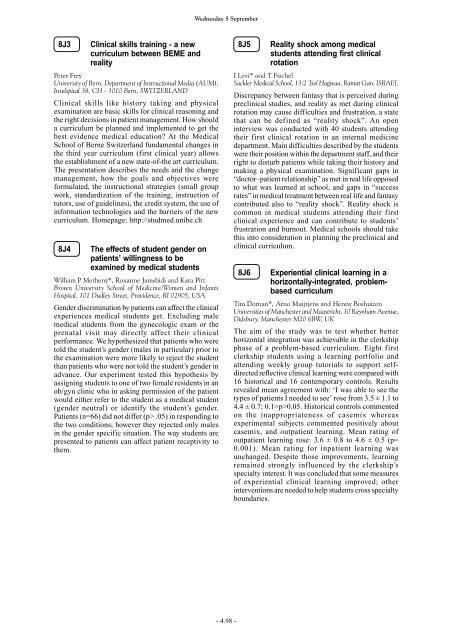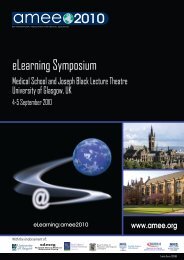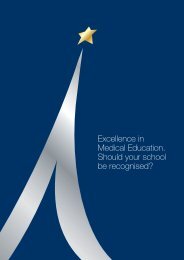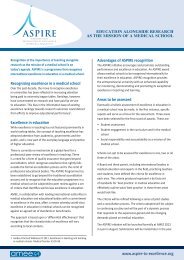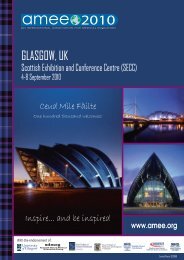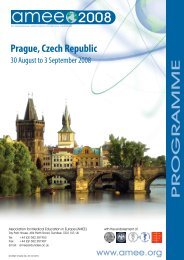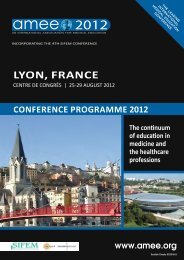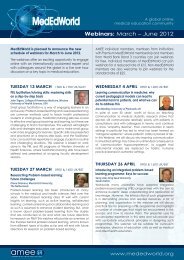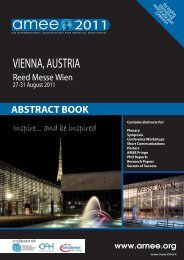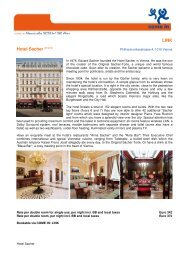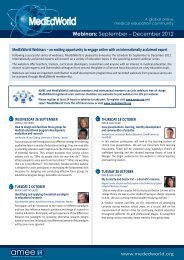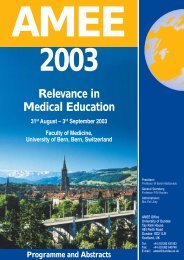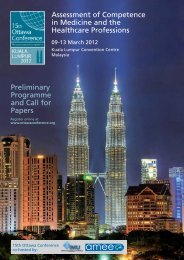AMEE Berlin 2002 Programme
AMEE Berlin 2002 Programme
AMEE Berlin 2002 Programme
You also want an ePaper? Increase the reach of your titles
YUMPU automatically turns print PDFs into web optimized ePapers that Google loves.
8J3 Clinical skills training - a new<br />
curriculum between BEME and<br />
reality<br />
Peter Frey<br />
University of Bern, Department of Instructional Media (AUM),<br />
Inselspital 38, CH - 3010 Bern, SWITZERLAND<br />
Clinical skills like history taking and physical<br />
examination are basic skills for clinical reasoning and<br />
the right decisions in patient management. How should<br />
a curriculum be planned and implemented to get the<br />
best evidence medical education? At the Medical<br />
School of Berne Switzerland fundamental changes in<br />
the third year curriculum (first clinical year) allows<br />
the establishment of a new state-of-the art curriculum.<br />
The presentation describes the needs and the change<br />
management, how the goals and objectives were<br />
formulated, the instructional strategies (small group<br />
work, standardization of the training, instruction of<br />
tutors, use of guidelines), the credit system, the use of<br />
information technologies and the barriers of the new<br />
curriculum. Homepage: http://studmed.unibe.ch<br />
8J4 The effects of student gender on<br />
patients’ willingness to be<br />
examined by medical students<br />
William P Metheny*, Roxanne Jamshidi and Kara Pitt<br />
Brown University School of Medicine/Women and Infants<br />
Hospital, 101 Dudley Street, Providence, RI 02905, USA<br />
Gender discrimination by patients can affect the clinical<br />
experiences medical students get. Excluding male<br />
medical students from the gynecologic exam or the<br />
prenatal visit may directly affect their clinical<br />
performance. We hypothesized that patients who were<br />
told the student’s gender (males in particular) prior to<br />
the examination were more likely to reject the student<br />
than patients who were not told the student’s gender in<br />
advance. Our experiment tested this hypothesis by<br />
assigning students to one of two female residents in an<br />
ob/gyn clinic who in asking permission of the patient<br />
would either refer to the student as a medical student<br />
(gender neutral) or identify the student’s gender.<br />
Patients (n=66) did not differ (p> .05) in responding to<br />
the two conditions; however they rejected only males<br />
in the gender specific situation. The way students are<br />
presented to patients can affect patient receptivity to<br />
them.<br />
Wednesday 5 September<br />
- 4.98 -<br />
8J5 Reality shock among medical<br />
students attending first clinical<br />
rotation<br />
I Levi* and T Fischel<br />
Sackler Medical School, 13/2 Tsel Hagivaa, Ramat Gan, ISRAEL<br />
Discrepancy between fantasy that is perceived during<br />
preclinical studies, and reality as met during clinical<br />
rotation may cause difficulties and frustration, a state<br />
that can be defined as “reality shock”. An open<br />
interview was conducted with 40 students attending<br />
their first clinical rotation in an internal medicine<br />
department. Main difficulties described by the students<br />
were their position within the department staff, and their<br />
right to disturb patients while taking their history and<br />
making a physical examination. Significant gaps in<br />
“doctor–patient relationship” as met in real life opposed<br />
to what was learned at school, and gaps in “success<br />
rates” in medical treatment between real life and fantasy<br />
contributed also to “reality shock”. Reality shock is<br />
common in medical students attending their first<br />
clinical experience and can contribute to students’<br />
frustration and burnout. Medical schools should take<br />
this into consideration in planning the preclinical and<br />
clinical curriculum.<br />
8J6 Experiential clinical learning in a<br />
horizontally-integrated, problembased<br />
curriculum<br />
Tim Dornan*, Arno Muijtjens and Henny Boshuizen<br />
Universities of Manchester and Maastricht, 10 Raynham Avenue,<br />
Didsbury, Manchester M20 6BW, UK<br />
The aim of the study was to test whether better<br />
horizontal integration was achievable in the clerkship<br />
phase of a problem-based curriculum. Eight first<br />
clerkship students using a learning portfolio and<br />
attending weekly group tutorials to support selfdirected<br />
reflective clinical learning were compared with<br />
16 historical and 16 contemporary controls. Results<br />
revealed mean agreement with: ‘I was able to see the<br />
types of patients I needed to see’ rose from 3.5 ± 1.1 to<br />
4.4 ± 0.7; 0.1>p>0.05. Historical controls commented<br />
on the inappropriateness of casemix whereas<br />
experimental subjects commented positively about<br />
casemix, and outpatient learning. Mean rating of<br />
outpatient learning rose: 3.6 ± 0.8 to 4.6 ± 0.5 (p=<br />
0.001). Mean rating for inpatient learning was<br />
unchanged. Despite those improvements, learning<br />
remained strongly influenced by the clerkship’s<br />
specialty interest. It was concluded that some measures<br />
of experiential clinical learning improved; other<br />
interventions are needed to help students cross specialty<br />
boundaries.


